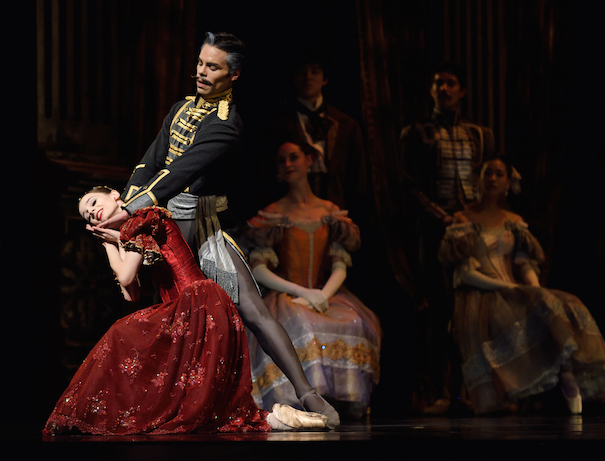
Why is it that shy, bookish girls always fall for self-absorbed and vain men? So the sweet Tatiana falls for the arrogant Onegin, leading to disaster. Pushkin’s classic story in verse has been the basis of opera and ballet, plays and films. As well as being translated into numerous languages, including a controversial English translation by Vladimir Nabokov.
Translating a psychologically complex novel-length poem into movement requires compression and reconfiguring into theater’s physical trappings, however. John Cranko’s three-act ballet begins its journey with the musical compilation of Tchaikovsky’s work by Kurt-Heinz Stolze that follows a reduction of the story into six scenes. Interestingly, none of the music used comes from Tchaikovsky’s opera version of the story. The music often seems unlikely. It is, however, Tchaikovsky, and even though the score is taken from disparate instrumental works it is lyrically gracious and clearly danceable. Martin West did a formidable job conducting the excellent SF Ballet orchestra.
Much of the social criticism in the original work is buried under the glamour that accompanies narrative ballets set in the 19th-century. Gorgeous sets and costuming, even for the peasants. The ballet focuses instead on the two main characters: Tatiana, an innocent romantic girl raised in the country, and Onegin, a vain upper-class aesthete who inherits a house in the country but who is repelled by this simpler life that lacks culture and sophistication.
In the opening night performance Maria Kochetkova danced the role of Tatiana and Vitor Luiz that of Onegin. The two make brilliant partners, moving surely and smoothly through Cranko’s intriguing choreography. Expressively, Kochetkova is most alluring as the young Tatiana. With her small stature and long legs she conveys delicacy and vulnerability. She is less convincing as the mature Tatiana, who has married and become a model of cultural elegance and sophistication, but she never fails to impress in her dancing.
Luiz looks perfect as her partner, slinging the petite dancer through daring and, at times, terrifying lifts. He is a wonderful dancer and carries off the portrait of Onegin’s cruel narcissism well, though the part must be taxing. Their first act duet, set as a dream sequence in Tatiana’s bedroom, is thrilling. Tatiana, unable to sleep, wanders her bedroom and finds herself in front of her full-length mirror. There she sees not only her own image but that of Onegin, who comes alive in her mind. Onegin enters the room and dances with her. It’s suggestive of Le Spectre de la Rose, blending innocence and erotic longing.
Lauren Strongin danced the part of Olga, Tatiana’s vivacious and coquettish sister who is affianced to the sensitive and adoring poet Lensky, danced by Gennadi Nedvigin. Spirited and dramatically dead-on, the two dancers made gorgeous partners. In the second act, Onegin snubs Tatiana, who has written him a letter confessing her love, by flirting with Olga. His rash cruelty has dire effects. Lensky takes the flirting seriously and challenges Onegin to a duel. Lensky will lose this duel, forcing Onegin into exile. Tatiana will marry Prince Gremin, an older aristocratic relative, and through him find both romantic love and adulthood. Joan Boada danced Prince Gremin with grace and tenderness. The cast changes throughout the ballet’s run.
Both Nedvigin and Boada are retiring this year after a combined 35-year tenure as principal dancers at SF Ballet. The Russian-born Nedvigin will be taking the post of Artistic Director at Atlanta Ballet in August.
– Jaime Robles
San Francisco Ballet’s Onegin continues through May 8. For tickets and information, visit sfballet.org.
Photo: Maria Kochetkova and Joan Boada in San Francisco Ballet’s production of John Cranko’s Onegin. Photo by Erik Thomasson.
